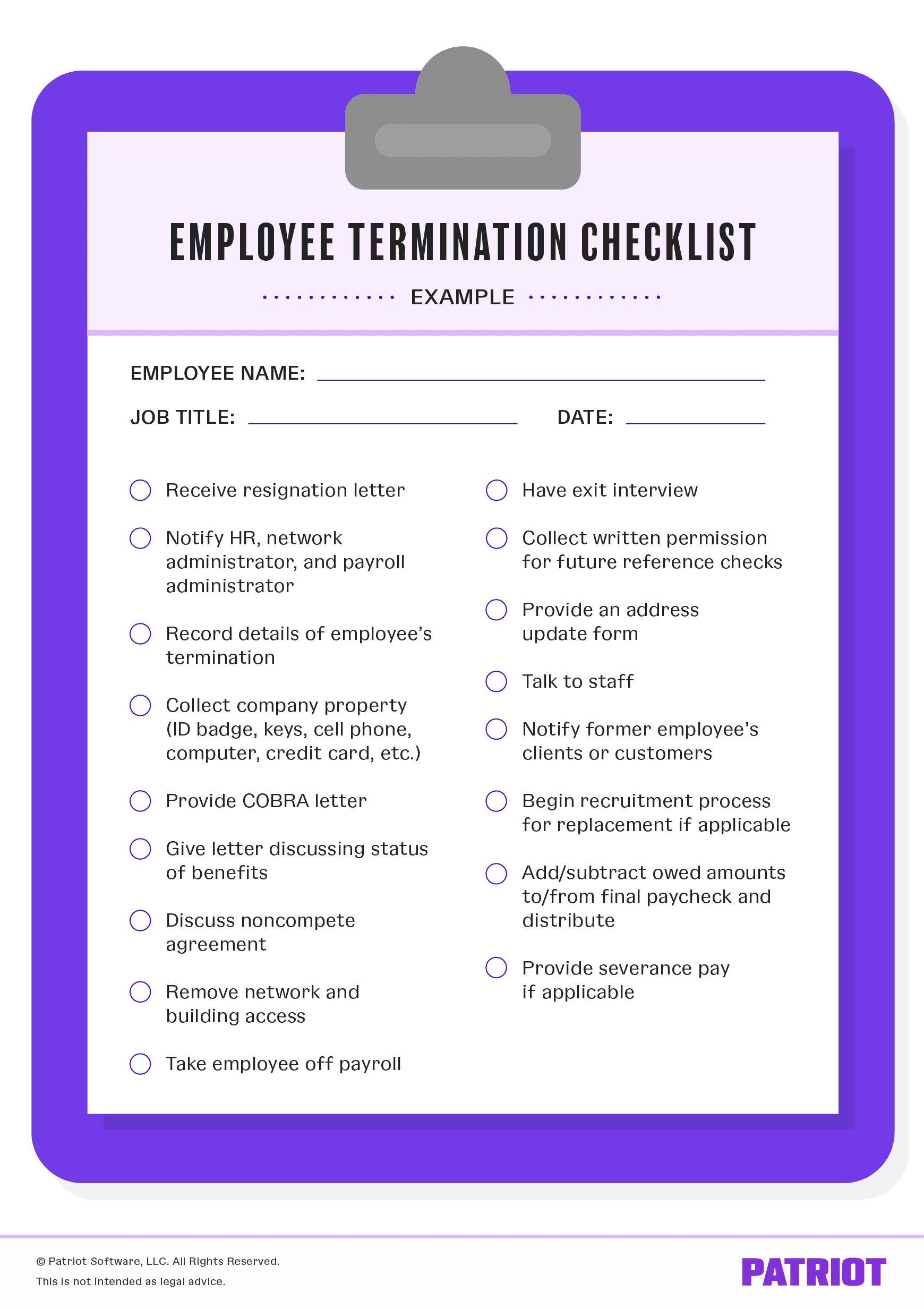Here’s a number for you: 47.2%. That was the 2021 annual total separation rate (aka the number of total separations as a percent of annual average employment). And here’s one more number for you: 4,258,000. That’s the number of employees who quit their jobs in January 2022.
Quits are happening in businesses nationwide like there’s no tomorrow. In some cases, there’s not much you can do to stop it from happening in your business. But, you must respond to it. One way to make employee separations easier is to have a termination checklist ready to roll.
And hey, we know you have a million other responsibilities. So, we’ve created an employee termination checklist to get you started.
Termination checklist steps
Newbie and veteran employers alike struggle with the employee resignation process. When an employee tells you they’re leaving your business, you might not know the exact employee termination procedure.
Collection, distribution, and discussions, oh my. When you start putting together a job termination checklist, the tasks add up.
To start, you must collect information and property, pass out employee termination forms, and have a formal discussion with the employee. And, you need to update your payroll and HR systems to reflect the resignation.
Take a look at our detailed exit checklist for terminated employees.
1. Talk to the employee
There are a number of ways an employee can tell you they’re quitting. They might:
- Send you an email
- Ask for a meeting
- Put a resignation letter on your desk
- Tell you in your office
Regardless of how an employee tells you, be consistent and have a private conversation with them. Typically, it’s best to talk face-to-face.
During your conversation with the employee, ask for a formal resignation letter if they haven’t already given you one. You should also talk about the next steps in the process, including when the employee’s last day is, what their responsibilities are, and when you’ll have an exit interview.
Many businesses require two weeks’ notice from the time an employee tells you they’re leaving. Ask the employee to wrap up their work during this time.
2. Collect company property
Before or during the resigning employee’s last day, collect any company property you provided to them.
Examples of company property include:
- Car
- Computer
- Cell phone
- Credit card
- Keys
3. Pass out paperwork
Before an employee leaves, pass out and collect termination forms for employees, including:
- Change of address form
- Benefits letters
- COBRA information
- Severance pay information
Provide a change of address form in case the employee moves after quitting. That way, the employee receives Form W-2 when you send it to their address.
Distribute letters indicating the employee’s benefits as well. The letter should detail the status of their health insurance, retirement plan, and any other small business employee benefits they received at your company.
If you must provide COBRA (Consolidated Omnibus Budget Reconciliation Act) coverage, give your employee information about this. COBRA allows employees to temporarily continue their insurance plans even after they are terminated. Contact your group health plan and tell them the employee is eligible to receive COBRA continuation coverage.
If you offer severance pay to your terminated employees, communicate to the employee how they’ll receive their wages.
Psst–Want more payroll articles like this?
Get the latest payroll news delivered straight to your inbox.
Subscribe to Email List4. Have an exit interview
Having an exit interview is one of the most important parts of the termination process. Normally, a representative from HR is present during the exit interview.
During the exit interview, you can answer any questions the employee has about benefits or the final paycheck. If you asked the employee to sign a non-compete agreement when they started working at your business, review it with them during the exit interview. Make what the employee is not allowed to do clear, as well as the other terms of the noncompete.
After you talk about the legal parts of the employee’s departure, ask questions about their employment. Find out what they liked and didn’t like about working at your business. Encourage communication, and take notes. That way, you can make workplace changes if you see fit.
5. Let people know
Although you don’t need to broadcast your employee’s desire to leave over a loudspeaker, you need to let people know.
Make sure to notify:
- Your HR department or representative
- Members in the employee’s department
- The employee’s clients or customers
An HR department or representative will likely be heavily involved in the process. So, HR needs to know so they can prepare paperwork and update files. If you have an employee who handles payroll, make sure you notify them, too.
Let the rest of your employees know that their co-worker is leaving. An employee’s resignation could affect the workload of your current staff, especially if you don’t plan to fill the position. And, being open with your employees is key for morale.
You might also need to let the resigning employee’s clients or customers know they are leaving. That way, you can transfer information over to a new employee and provide another employee’s contact information to the customer. Send an email or letter informing clients of employee resignation.
6. Remove employee access
When the employee leaves, they should not have access to anything at your business. Remove their access to the:
- Building: Whether they enter with a key, use a code, or scan a badge, make sure the employee cannot get into the building.
- Computer network: Employees should no longer receive company updates, messages from co-workers, or calls from clients. Employees leaving should not be able to log into company databases, either.
7. Update records
As a business owner, you must maintain accurate records. When an employee leaves, make sure your business reflects the change.
Remove terminated employees from your payroll. If you use payroll and HR software, update your records to show that the employee is not working for you.
Hang onto payroll records for at least three years, according to the FLSA. And, hold onto records of employment taxes for at least four years, according to the IRS.
If you fired the employee, keep records to back up your reasoning (in case of a lawsuit). These records can include disciplinary actions or performance reviews.
8. Distribute final paycheck
Do you know your final paycheck laws by state? Your state’s laws may determine when you give employees their final paychecks (e.g., during the exit interview or the next regular pay date).
Before distributing the final paycheck, keep in mind that you may owe the employee:
- Accrued paid time off
- Bonus pay
- Commissions
- Reimbursements
If the employee has accrued paid time off they’re entitled to, include the value of it in their final paycheck. You can find the value by multiplying how many hours they have accrued by their hourly rate. Also include bonus pay, commissions, or any reimbursements you owe employees.
Keep in mind that the employee may owe you:
- Personal time off they took but didn’t accrue
- Salary advance funds
Some employees use personal time off before they earn it. If an employee spends personal time they have not yet accrued, you may need to deduct it from their final paycheck. And if you provided a salary advance, the employee must pay you back for that. If the amount the employee owes is greater than their final paycheck, you need to collect the remainder from them.
Employee termination checklist example
Take a look at our sample termination checklist template to get a feel for how your checklist might look.

A visual employee exit checklist like this shows you what steps you’ve done and which you still need to do.
Tips for handling employee resignation
You might feel blindsided when you lose an employee. Not to mention, replacing an employee is expensive. Regardless of the financial burden and time constraints employee turnover puts on your business, you need to keep your cool.
Knowing what to say when an employee resigns can be a challenge. First and foremost, stay professional. Have a discussion with the parting employee. Put your personal relationship with the employee aside when you talk with them.
Ask questions about why the employee is leaving and where they are going, but don’t interrogate them. You shouldn’t put the employee down, talk badly about them, or ignore the situation.
Talk about what work the employee needs to wrap up and let them know what other steps they need to take before leaving.
Make sure you don’t neglect the rest of your employees. They might have questions or concerns about taking on the resigning employee’s workload. Create a plan and keep the lines of communication open.
This article has been updated from its original publication date of March 7, 2018.
This is not intended as legal advice; for more information, please click here.


